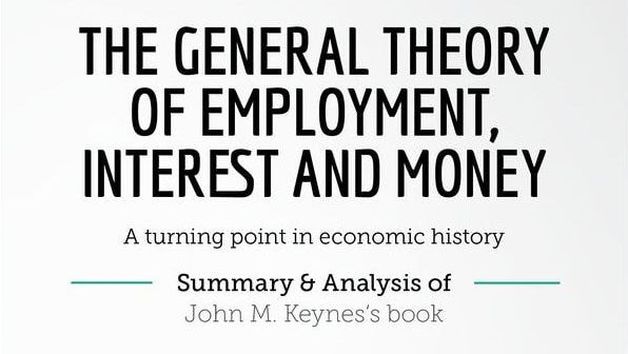ECONOMICS STUDY CENTER, UNIVERSITY OF DHAKA
|
Farzin Mumtahena, Jinat Jahan Khan, Sumiya Tasnim Oyshee, Masafi Mustafa Haider Most of us are familiar with the term “Keynesian economics” but know very little about the roots of this concept. Keynesian economics gets its name and principles from British economist John Maynard Keynes (1883–1946), who is regarded as the founder of modern macroeconomics. And none other than his book The General Theory of Employment, Interest, and Money sought to bring about a revolution (commonly referred to as the Keynesian Revolution) and became the cornerstone of Keynesian thought. Background When most countries of the world were experiencing the gravest depression of the last two hundred years (1929-36), economists of the time faced a challenge in the problem of increasing unemployment, shrinking national income, falling prices and failing firms. While conservative economists waited for the free- economic system to correct its ailment itself, Keynes believed otherwise. This led to the publication of his most famous work- The General Theory of Employment, Interest, and Money in February 1936. Written during the height of the depression, the book offered a new explanation of the depression and the unemployment that plagued it. Summary The General Theory of Employment, Interest, and Money is mainly focused on some factors like unemployment, inflation, the supply of money, a nation's total output and income, etc. There are also some ideas about unemployment equilibrium, liquidity traps, the paradox of thrift and the importance of capital overhang. The main plank of Keynes’s theory is the assertion that aggregate demand—measured as the sum of consumption, investment, government purchases, and net exports —is the most important driving force in an economy. Before the publication of this book, labor market rigidity was held responsible for preventing working wages from falling to a point where supply and demand were in equilibrium. But Keynes wrote in his book that unemployment might be caused by dampened demand for goods and services during a recession, thus making state intervention absolutely necessary to encourage booms in the economic cycle.  Monetarists used to believe that interest rates led to a balance between investment and savings. As a result, there would be an equilibrium in the market for goods and services. But in The General Theory of Employment, Interest, and Money, Keynes contested that interest rate was not the principal function for maintaining the balance of investment and savings, but for the balance of demand and supply of money. He further theorized if the money supply was expanded unemployment problem could be reduced. However, monetarists were against this solution as they thought that it would lead to inflation in the long run. Influence on Policy-making This book, and Keynes more generally, was hugely influential on many of the policy decisions in the US and Britain during the first half the 20th century and it continues to be influential today in a variety of forms. For example, in 1944 the British White Paper on Employment Policy stated that “the government accepts as one of their primary aims and responsibilities the maintenance of a high and stable level of employment after the war.” In the United States, the Employment Act of 1946 stated: “The Congress hereby declares that it is the continuing policy and responsibility of the Federal Government to… promote maximum employment, production, and purchasing power.” Similar programs were adopted in Sweden in 1944 by the Social Democrats, and in Canada and Australia. Praises and Criticisms Many of Keynes’s ideas were revolutionary; almost all were controversial and The General Theory was no different. As the book challenged established classical economics and introduced new concepts, it was not a surprise that its ideas were popular amongst young economists but not amongst the traditional ones. Paul Samuelson’s witty comment depicts exactly that: “The General Theory caught most economists under the age of 35 with the unexpected virulence of a disease first attacking and decimating an isolated tribe of south sea islanders. Economists beyond 50 turned out to be quite immune to the ailment. With time, most economists in between began to run the fever, often without knowing or admitting their condition.” Nobel laureate Paul Krugman has made the following comment: “A businessman who warns that falling confidence poses risks for the economy is a Keynesian, whether he knows it or not. A politician who promises that his tax cuts will create jobs by putting spending money in people's’ pockets is a Keynesian, even if he claims to abhor the doctrine. Even self-proclaimed supply-side economists, who claim to have refuted Keynes, fall back on unmistakably Keynesian stories to explain why the economy turned down in a given year.” Nobel Prize-winning Paul Samuelson said about the book, “when finally mastered, its analysis is found to be obvious and at the same time new. In short, it is a work of genius.” Richard Posner further acclaimed it by saying, “Economists may have forgotten The General Theory and moved on, but economics has not outgrown it, or the informal mode of argument that it exemplifies, which can illuminate nooks and crannies that are closed to mathematics. Keynes's masterpiece is many things, but ‘outdated’ it is not.” On the other hand, Keynes' economic theory was criticized by Marxist-oriented economists, who said that Keynes ideas, while well-intentioned, cannot work in the long run due to the contradictions in capitalism. A couple of these, that Marxians point to is the idea of full employment, which is seen as impossible under private capitalism; and the idea that government can encourage capital investment through government spending when in reality government spending could be a net loss on profits. David Romer wrote about the book’s shortcomings in Advanced Macroeconomics, “The view of supply in the General Theory assumes that the goods market is competitive and goods prices are completely flexible and that the source of nominal stickiness is entirely in the labor market. This raises the question of what occurs in the reverse case where the labor market is competitive and wages are completely flexible, and where the source of incomplete nominal adjustment is entirely in the goods market.” Conclusion There is no doubt that The General Theory still remains as one of the most influential yet extensively debated books in today’s time. This is a foundational book for anyone interested in the development of economics, particularly macroeconomics. While reading The General Theory and studying Keynes’s revolutionary ideas, do keep in mind these words from the book – “The difficulty lies, not in the new ideas, but in escaping from the old ones.” WriterResearch Team
0 Comments
Leave a Reply. |
Send your articles to: |





